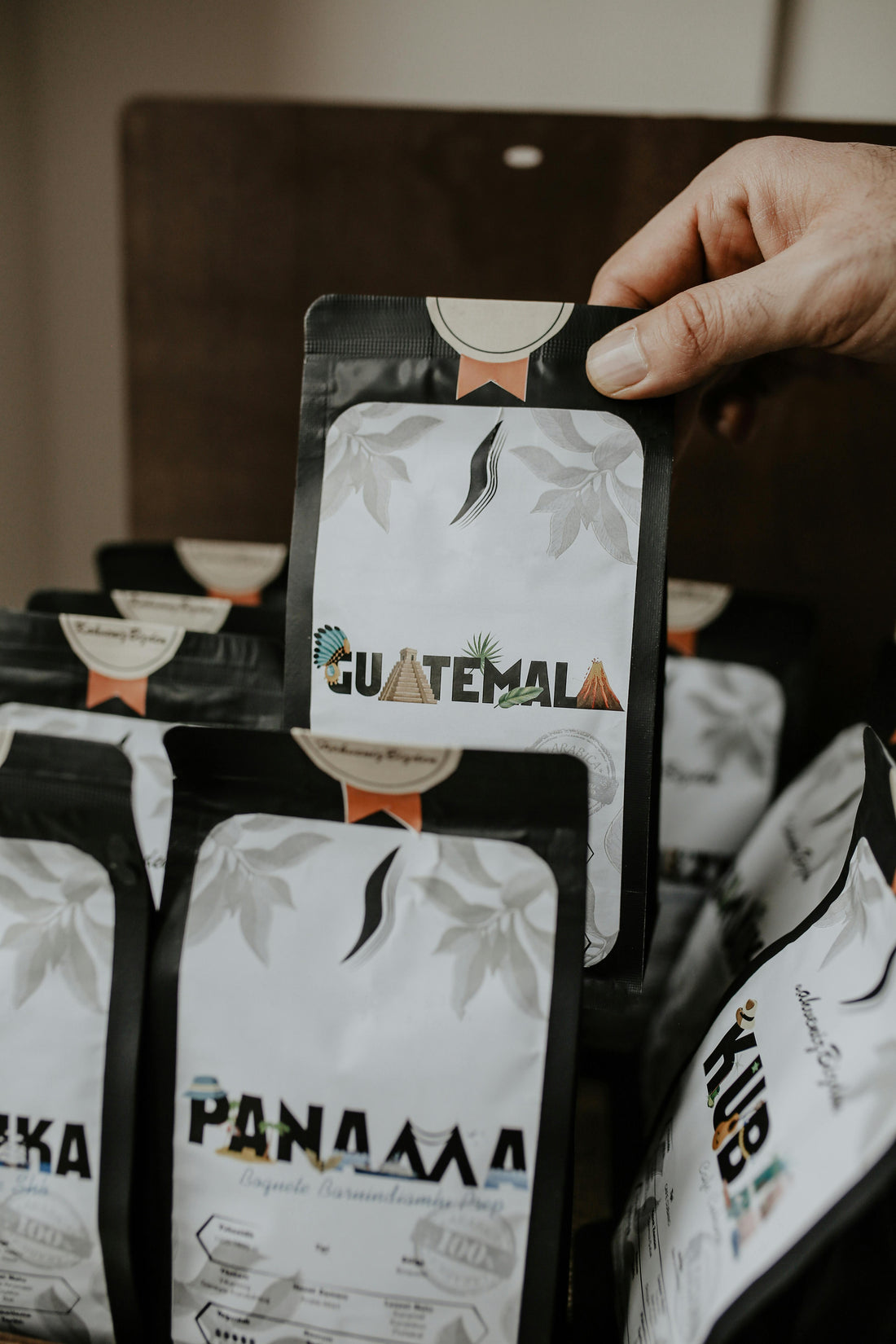
Unlocking the Secrets of Coffee: How Origin, Roast, Altitude, Processing, and More Shape Your Brew
Share
Hey coffee lovers! If you're anything like me, that morning cup (or afternoon pick-me-up) is more than just caffeine—it's an experience. But have you ever wondered why one bag of beans tastes bright and fruity while another is rich and chocolatey? The answer lies in a fascinating mix of factors: where the beans come from (whether single origin or in-house blends), how they're roasted, the altitude they grew at, their processing method, and even the date they were roasted. Today, we're diving deep into these elements, focusing on powerhouse coffee-producing countries like Colombia, Ethiopia, Kenya, and Brazil. We'll also cover how to decode those coffee bag labels so you can shop like a pro. Grab your favorite mug, and let's brew some knowledge!
The Role of Origin: Where Your Beans Call Home
Coffee's flavor starts with its roots—literally. The terroir (soil, climate, and geography) of different countries imparts unique characteristics to the beans. You can enjoy these as single-origin coffees, which highlight the distinct flavors of one region, or as in-house blends, where roasters combine beans from multiple origins for a balanced, harmonious profile. Here's a spotlight on four major players:
-
Colombia: Known for its balanced, mild coffees, Colombian beans often shine with notes of caramel, nuts, and subtle fruitiness. The country's diverse microclimates, thanks to the Andes Mountains, produce beans that are versatile for various roasts. Single-origin Colombians are smooth and approachable, while blends often use them as a base for consistency.
-
Ethiopia: The birthplace of coffee! Ethiopian beans are celebrated for their vibrant, complex profiles. You'll often find floral, tea-like qualities with bright acidity and fruity undertones like blueberry or citrus. Single-origin varieties like Yirgacheffe or Sidamo highlight Ethiopia's wild, heirloom genetics, making each sip an adventure. In blends, they add a lively, fruity kick.
-
Kenya: Kenyan coffees are bold and bright, with high acidity that pops like blackcurrant or tomato. They're prized for their juicy, wine-like body, often from SL28 and SL34 varieties grown in volcanic soil. Single-origin Kenyans are fruit-forward showstoppers, while blends use them to boost brightness and complexity.
-
Brazil: As the world's largest producer, Brazil offers nutty, chocolatey beans with low acidity and a full body. Think cocoa, peanuts, and a smooth finish—perfect for espresso blends. Single-origin Brazilians from regions like Minas Gerais are rich and approachable, while in-house blends often rely on them for a smooth, chocolatey backbone.
Choosing between single-origin and in-house blends depends on your vibe: single origins let a region's unique flavors shine, while blends craft a consistent, balanced cup.
Roast Levels: From Light to Dark and Everything In Between
Roasting transforms green beans into the aromatic gems we grind and brew. The level of roast dramatically affects taste, acidity, and body:
-
Light Roast: Roasted just until the first crack (around 385–410°F), these beans retain the most origin-specific flavors. Expect higher acidity, brighter notes like citrus or florals, and a lighter body. Great for showcasing fruity profiles from single-origin Ethiopian or Kenyan beans, but they can taste grassy if under-roasted.
-
Medium Roast: A sweet spot (410–430°F), balancing origin flavors with roast-developed caramelization. You'll get moderate acidity, fuller body, and notes like stone fruit or mild chocolate. Colombian and Brazilian beans, whether single-origin or blended, often excel here, offering a versatile, crowd-pleasing cup.
-
Dark Roast: Pushed to the second crack (430–450°F+), these beans develop bold, smoky, bittersweet flavors with low acidity and heavy body. Chocolatey, nutty, or even charred notes dominate, often masking origin subtleties. Brazilian blends love a dark roast for that robust espresso vibe, but it can turn fruity single-origin beans like Ethiopian into something more uniform.
Remember, darker roasts have slightly less caffeine due to longer heat exposure, but the difference is minimal.
Altitude Matters: Why Higher is Often Better
Coffee thrives at higher elevations (typically 1,200–2,200 meters above sea level), where cooler temperatures slow cherry ripening, leading to denser beans with more concentrated flavors.
-
Higher Altitude Benefits: Beans from lofty spots develop brighter acidity, complex sugars, and nuanced profiles. For example, Ethiopian highlands (like 1,800–2,200m) yield those explosive fruity notes in single-origin coffees, while Kenyan peaks contribute to that tangy brightness. In Colombia, high-altitude farms in the Sierra Nevada produce sweeter, more floral single-origin coffees. Even in Brazil's lower averages (800–1,300m), higher plots stand out with better acidity in both single origins and blends.
Lower altitudes often mean milder, less acidic beans—think everyday Brazilian blends. If you're chasing complexity, look for "high-grown" or specific altitude mentions on the bag.
Flavor Profiles: Fruity vs. Chocolatey and Beyond
Coffee flavors aren't random; they're influenced by origin, altitude, and more. Broadly:
-
Fruity Profiles: Bright, acidic, and lively—like berries, citrus, or tropical fruits. These shine in light roasts from high-altitude African single origins (Ethiopia and Kenya). Processing (more on that below) amplifies them; natural methods can add fermented berry notes.
-
Chocolatey Profiles: Rich, smooth, and comforting—with cocoa, nuts, or caramel. Medium to dark roasts from South American beans (Colombia and Brazil), whether single-origin or blended, highlight these, especially at moderate altitudes where body builds up.
Of course, hybrids exist: A medium-roasted Colombian single origin might blend subtle fruit with chocolate undertones, while an in-house blend could balance fruity and nutty notes. Tasting wheels can help you identify these—start with black coffee to let flavors pop!
Processing Methods: The Magic Behind the Bean
After harvest, cherries are processed to remove the fruit and dry the beans, hugely impacting taste:
-
Natural (Dry) Processing: Cherries dry whole in the sun, fermenting slightly for 2–4 weeks. This imparts sweet, fruity, boozy notes—like wine or berries. Single-origin Ethiopian naturals are iconic for their blueberry explosion, while Brazilian ones add body without acidity in blends.
-
Washed (Wet) Processing: Fruit is pulped off, beans fermented in water (24–72 hours), then washed and dried. Cleaner, brighter flavors result—think crisp acidity and pure origin notes. Single-origin Kenyan and Colombian coffees often use this for that tangy clarity, while blends benefit from their consistency.
-
Anaerobic Processing: A trendy method where cherries ferment in oxygen-free tanks (often with added yeasts or fruits). It creates wild, funky flavors like tropical punch or yogurt. Popular in single-origin Colombian and Ethiopian coffees, it can turn fruity profiles even more intense or add unexpected chocolatey depth to blends.
Experimenting with these can elevate your home brewing—naturals pair well with pour-overs, washed with espresso.
Roast Date: Freshness is Key
Coffee is perishable! The roast date on the bag tells you when flavors peak:
-
Ideal Window: Beans are best 1–4 weeks post-roast. Off-gassing (releasing CO2) happens in the first few days, so wait 24–48 hours before brewing. After 4 weeks, flavors fade—acidity dulls, and staleness creeps in.
-
Storage Tips: Buy whole beans, store in an airtight container away from light/heat/moisture. Grind just before brewing. If it's past a month, use it for cold brew, where subtleties matter less.
Producers often include a "best by" date, but roast date is more accurate—fresher means brighter, more vibrant cups, whether single-origin or blended.
Decoding Coffee Bag Packaging: Your Guide to Smart Shopping
Coffee bags are packed with info—here's how to read them like a barista:
-
Origin/Country: Look for single-origin (e.g., "Ethiopia Yirgacheffe") for purity or in-house blends (e.g., "House Espresso Blend") for balance and consistency.
-
Roast Level: Clearly stated as light, medium, dark—match to your taste (light for fruity single origins, dark for bold blends).
-
Altitude/Variety: Higher numbers signal complexity; varieties like Bourbon or Heirloom hint at flavors.
-
Processing Method: "Natural," "Washed," or "Anaerobic" clues you into taste twists.
-
Flavor Notes: Descriptive tags like "blueberry, chocolate" guide expectations—trust but verify with your palate.
-
Roast Date: Prioritize this over "best by." Also check for certifications (e.g., Fair Trade, Organic) for ethics.
-
Other Details: Farm name, producer, or QR codes for traceability add transparency.
Next time you're at a roastery or store, scan for these—it's like a flavor roadmap!
Wrapping Up: Brew Your Best Cup
From the misty highlands of Ethiopia to Brazil's vast plantations, every factor—from single-origin or in-house blend to processing—crafts your coffee's story. Whether you're craving a fruity light roast or a chocolatey dark one, understanding these elements empowers you to choose wisely. Experiment, taste mindfully, and remember: great coffee is about the journey as much as the jolt. What's your favorite origin or roast? Drop a comment below—I'd love to hear!
Happy brewing! ☕
